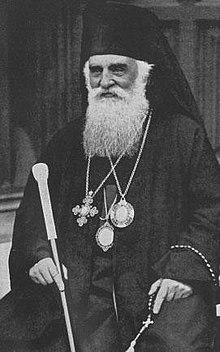Patriarch Miron of Romania | |
|---|---|
| By God's mercy, Archbishop of Bucharest, Metropolitan of Ungro-Vlachia, Locum tenens of the throne of Caesarea Cappadociae Patriarch of All Romania Prime Minister of Romania | |
 Miron in 1936 | |
| Church | Romanian Orthodox |
| Archdiocese | Bucharest |
| Elected | 1919 |
| Term ended | 1939 |
| Predecessor | Conon Arămescu-Donici |
| Successor | Patriarch Nicodim of Romania |
| Personal details | |
| Born | Elie Cristea 20 July 1868 |
| Died | 6 March 1939 (aged 70) Cannes, France |
| Buried | Romanian Patriarchal Cathedral |
| Nationality | Romanian |
| Signature | |
| Prime Minister of Romania | |
| In office 11 February 1938 – 6 March 1939 | |
| Monarch | Carol II |
| Deputy | Armand Călinescu |
| Preceded by | Octavian Goga |
| Succeeded by | Armand Călinescu |
| Personal details | |
| Political party | none |
| Profession | priest |
Miron Cristea (Romanian pronunciation: [miˈron ˈkriste̯a]; monastic name of Elie Cristea [eˈli.e]; 20 July 1868 – 6 March 1939)[1] was a Romanian cleric and politician.
A bishop in Hungarian-ruled Transylvania, Cristea was elected Metropolitan-Primate of the Orthodox Church of the newly unified Greater Romania in 1919. As the Church was raised to a rank of Patriarchate, Miron Cristea was enthroned as the first Patriarch of the Romanian Orthodox Church in 1925.
In 1938, after Carol II banned political parties and established a royal dictatorship, he chose Cristea to be Prime Minister of Romania, a position in which he served for about a year (between 11 February 1938 and his death on 6 March 1939).